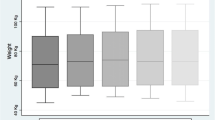Abstract.
The two commercially available taxanes (paclitaxel and docetaxel) are widely employed in standard oncologic practice. Toxicity of the agents includes bone marrow suppression (principally neutropenia), complete alopecia, and hypersensitivity reactions. While both drugs can cause neurotoxicity and myalgias/arthralgias, this is a greater clinical concern with paclitaxel. Docetaxel can be associated with the development of significant fluid retention (e.g., edema, ascites, pleural effusions), the incidence and severity of which appear to be limited by prophylactic treatment with corticosteroids both before and after each treatment. If patients are monitored closely (e.g., for hypersensitivity reactions, bone marrow suppression) the taxanes have a favorable side effect profile, and it is currently uncommon for treatment to be discontinued because of the development of excessive toxicity.
Similar content being viewed by others
Author information
Authors and Affiliations
Additional information
Electronic Publication
Rights and permissions
About this article
Cite this article
Markman, M. Managing taxane toxicities. Support Care Cancer 11, 144–147 (2003). https://doi.org/10.1007/s00520-002-0405-9
Issue Date:
DOI: https://doi.org/10.1007/s00520-002-0405-9




